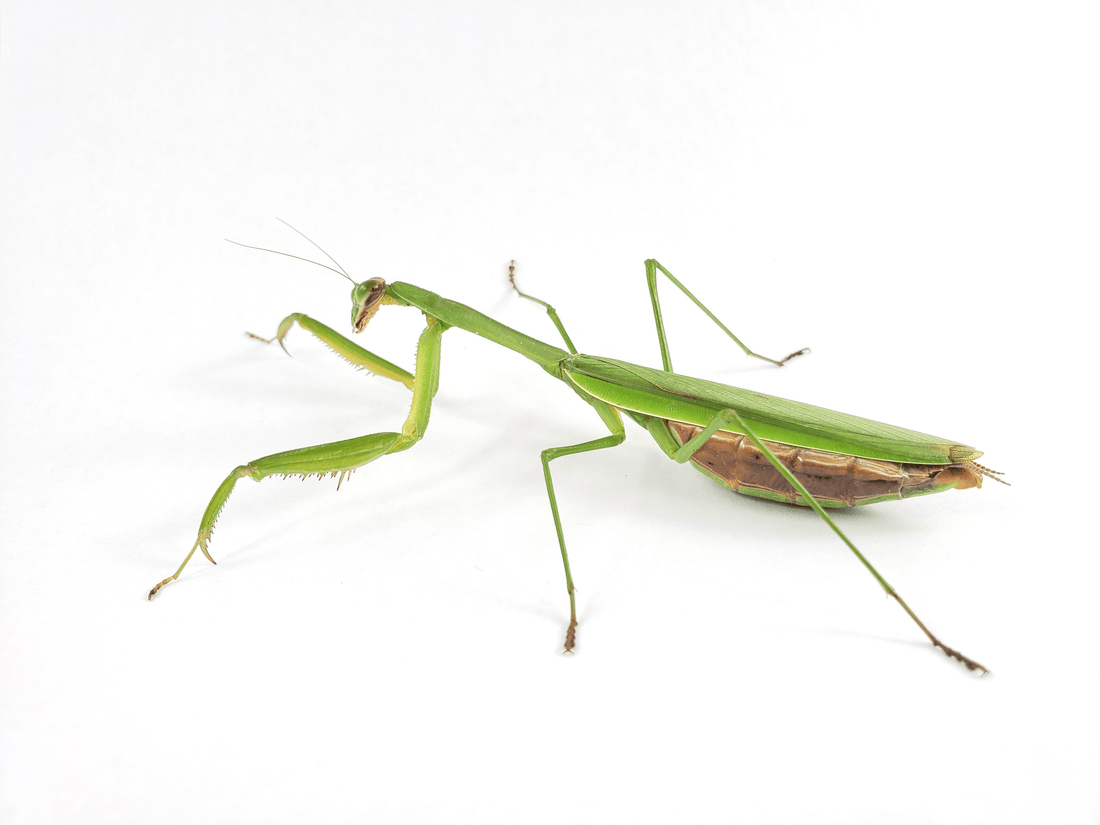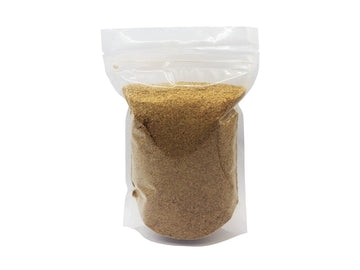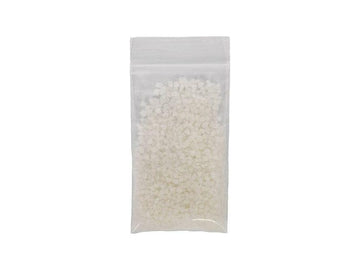Chinese mantises (Tenodera sinensis) are medium-large, diurnal, carnivorous invertebrates originally found throughout east and southeast Asia. However, they have been introduced and are now widespread throughout the continental United States and Hawaii.
The Chinese mantis grows to around 4” long, and has a long, sticklike body, large eyes, triangular head, long antennae, long abdomen, slender legs, and clawlike forelimbs. They are able to fly when needed. Coloring is brown to green, and the brown ones have a green stripe on their wings.
The Chinese mantis is very popular in the pet trade. Juveniles can be difficult to keep alive, so it’s best to buy your first Chinese mantis as an adult or subadult. Total lifespan for this species is 8-12 months, with females living longer.
Minimum terrarium size for Chinese mantises
The widely-accepted minimum formula for housing praying mantises is:
- Length = 2x mantis length
- Width = 2x mantis length
- Height = 3x mantis length
Height is particularly important, as mantises need vertical space in order to molt (shed their exoskeleton) and grow properly.
Using the above formula, the enclosure for an adult-sized Chinese mantis should be at least 8”L x 8”W x 12”H and made of glass, plastic, or mesh. Chinese mantis nymphs can be raised in a 32oz deli cup with a ventilated top until they’re large enough to move to their adult home.
Cohabitation is not recommended with Chinese mantises, as one is very likely to eat the other(s).
Do Chinese mantises need special lighting?
If your mantis’ enclosure is placed in a room that receives ~12 hours/day of bright natural or artificial light, then additionally lighting equipment is unnecessary. However, if your mantis is being kept in a dark room or you wish to put live plants in the enclosure, then you will need additional lighting equipment such as a small white fluorescent or LED grow light around 6500K.
Best temperature for Chinese mantises
If you are raising a young Chinese mantis in a 32oz deli cup or Kritter Keeper, then it’s best to keep them at an ambient temperature of around 75°F.
If you are keeping a Chinese mantis in an adult-sized glass or mesh enclosure, it’s best practice to provide a temperature gradient via heat lamp that will allow it to choose the temperature it wants to be at. The Zoo Med Nano Dome Lamp Fixture and 25w Zoo Med Nano Basking Spot bulb is a good combination to start with. Average air temperature should be between 70-80°F, and basking temperature between 82-88°F, which you can monitor with a digital thermometer placed in the middle of the enclosure.
Mantises tend to hang upside-down from the top of their enclosure, so if you put the lamp directly on top of the mesh, there’s a good chance that your pet will get burned! Instead, suspend the lamp from a lamp stand.
The heat lamp should be turned off at night.
Best humidity levels for Chinese mantises
Providing the right amount of humidity is very important for making sure that your praying mantis is able to molt properly and stays generally healthy. Too high and too low will both cause problems. For the Chinese mantis, their comfort zone is between 50-65% on average.
Lightly mist your mantis’ enclosure at least once per day with a spray bottle to both increase the humidity and provide drinking water. Mesh enclosures will need misting more often than glass or plastic ones.
Keep track of the humidity in your mantis’ enclosure with a digital hygrometer.
Best substrate for Chinese mantises
Your Chinese mantis terrarium should have at least 1-2” of substrate on the bottom to help maintain the humidity. Here are some moisture-friendly materials you can use:
- Zoo Med Creatures Eco Soil
- Zoo Med Creature Soil
- Zoo Med ReptiBark
- Eco Earth Plantation Soil
- Exo Terra Forest Bark
This substrate will need to be replaced weekly and the enclosure thoroughly rinsed out with hot water to maintain good hygiene.
Alternatively, you can use a bioactive-ready soil substrate with springtails, isopods, beneficial bacteria and mycorrhizae fungi, and live plants to create a bioactive setup. This can be a little complicated to balance, and requires additional research to create. However, the big benefit with bioactive is that it helps keep the enclosure clean by naturally breaking down waste.
How to decorate a Chinese mantis terrarium
In order to reduce stress, prolong your mantis’ lifespan, and encourage natural behaviors, your Chinese mantis needs both objects to climb and hide behind in its enclosure. Here are some ideas of things you can use:
- twigs
- thin vines
- live plants
- artificial foliage
Use hot glue to attach climbing objects to the sides and bottom of the enclosure at different angles for variety. Hanging upside-down all the time may cause physical disfigurement in young mantids.
However you arrange your enclosure, make sure to leave enough open space at the top for twice your mantis’ height to use during molting.
What to feed to a Chinese mantis
Praying mantises are carnivores, which means that they eat other insects and small animals in order to get the nutrition that they need. Offer prey every other day, as much as your mantis will eat in one session. Although you can let your mantis hunt its prey by simply tossing the bugs into the enclosure, it’s best to offer food via tweezers so you know for sure that your pet is eating.
Feeders should be live and no more than 1/3 your mantis’ length. Offer a variety of different bugs so your mantis can benefit from more balanced nutrition. Here are some options:
- Flightless fruit flies
- Rice flour beetles
- Bean beetles
- Black soldier flies and larvae
- Blue/green bottle flies
- Dubias
- Discoids
- Silkworms
- Hornworms
- Mealworms
- Superworms
- Katydids
- Grasshoppers
- Wax moths
Due to disease-related concerns, it’s best to avoid feeding crickets to your praying mantis.
Before offering prey to your mantis, make sure the prey has been well fed and hydrated for at least the last 24 hours. This helps maximize your mantis’ lifespan by making sure it’s getting quality nutrition from each of its meals. Here are some good formulas for gutloading feeder insects:
- Dubia Diet
- Repashy Bug Burger
- Repashy Superfly
- Repashy Superhorn
How to handle your Chinese mantis
As a general rule, invertebrates are “look-but-don’t-touch” pets: fun to watch, but not to be handled regularly. Some are more tolerant of humans than others, though, and Chinese mantises tend to have fairly calm dispositions. If you want to hold your mantis, try setting your hand in front of it and encouraging it to walk onto your hand. However, don’t try to handle it very often, as this is stressful.
Never handle or otherwise disturb your mantis within ~3 days after a molt, as they’re very soft after molting, and get injured easily during this time. Note that molting (shedding) occurs every 2-3 weeks for juveniles and 3-4 weeks for subadults, and it’s normal for mantises to refuse food before a molt.
*This care sheet contains only very basic information. Although it’s a good introduction, please further your research with high-quality sources. The more you know, the better you will be able to care for your pet!
"File:Chinese mantis (Tenodera sinensis) side.png" by SwimSusan is licensed under CC BY-SA 4.0











